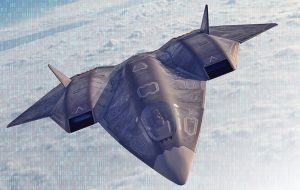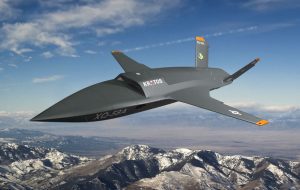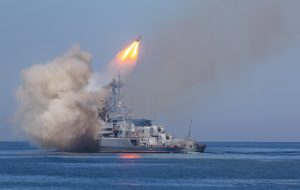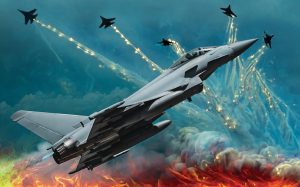Emerging trends in superpowers regarding military technologies such as artificial intelligence, lethal autonomous weapons, hypersonic weapons, directed energy weapons, biotechnology and quantum computing, will undoubtedly have serious repercussions on the future of armies, warfare and international security.
This file offers an overview of these new military technologies for 2023 and beyond as well as their potential impacts on the future of military power, especially major powers such as the United States, China and Russia.
Furthermore, it will identify and examine the challenges these technologies pose, including how to quickly acquire and protect them, as well as stabilize their financing and governance and deal with the challenges associated with the human element.
The study will also discuss international institutions’ most important initiatives to monitor or regulate the use of these technologies.
Finally, it will explore the trends associated with these emerging military technologies from 2023 onwards.
1- Artificial intelligence (AI)
The term artificial intelligence (AI) is generally used to refer to a computer system capable of at least human-level awareness, and it is divided into three categories: Artificial Narrow Intelligence (ANI), Artificial General Intelligence (AGI) and Artificial Super Intelligence (ASI).
ANI systems can only perform the specific task for which they are trained, while AGI systems are capable of performing a wide range of tasks even if they aren’t trained for them, and ASI systems surpass the level of human cognitive performance in almost all fields.
So far there aren’t many publicly known applications of AGI and ASI systems in the field of weapons development, while ANI systems applications dominate the fields including intelligence, surveillance, reconnaissance, Cyber, command and control operations, as well as semi-autonomous and autonomous vehicles.
The objective of these applications and technologies is to replace the human element in weapons operations with technologies, effectively giving them the ability to do more complex and cognitively demanding tasks, to achieve the following goals:
- Interact faster than systems that depend on human input.
- Deal with the exponential increase in the amount of data available for analysis.
- Enable the use of new operational concepts, such as swarming (i.e., the cooperative behaviour in which autonomous weapons independently coordinate among themselves to achieve a common mission), which gives them an advantage against an enemy’s defensive systems.
However, the use of ANI in weapons poses various challenges. For example, such systems may be subject to algorithmic bias, which can lead to misidentifications resulting in the unintentional death of civilians.
Furthermore, the Enemy can disrupt AI-based target recognition or redirect it by exploiting vulnerabilities and using “deepfakes” of images, audio and video.
The US Department of Defence’s investments in artificial intelligence amounted to more than $600 million in 2016, which increased to $1.1 billion in 2023, and in addition to 685 active artificial intelligence projects, it established the Joint Artificial intelligence Centre (JAIC) to coordinate the efforts of these projects, it was also given acquisition authority, to support the goal of introducing AI capabilities at the departmental level.
By the end of 2021, Deputy Secretary of Defence Kathleen Hicks ordered the establishment of two new agencies, the Chief Digital Office and the Artificial Intelligence Office, to succeed the JAIC and report directly to the Deputy Minister of Defence.
In March 2021, the National Security Committee on Artificial Intelligence (NSCAI) submitted a report to congress recommending investment in research and development, utilizing artificial intelligence in national security operations and training, employing talented people in the field of artificial intelligence, protecting and benefiting from American technological advantages, and organizing global cooperation in the field of artificial intelligence, and the Minister of Defence is required to submit an annual status report to the congressional defence committees to follow up on the implementation of these recommendations.
China is widely seen as the closest competitor to the US in the applications of artificial intelligence in the military field.
China’s 2017 “Next Generation Artificial Intelligence Development Plan” describes AI as a “strategic technology” that has become “the focus of international competition”.
Recent advancements in this field show China’s ability to achieve its objectives regarding the development of artificial intelligence, especially in language and face recognition technologies, and integrating them into air, land, and sea targeting, surveillance and espionage networks, thereby integrating them into autonomous naval military vehicles and weapons.
China’s National Intelligence Law stipulates that companies and individuals must support, assist and cooperate with the work of China’s national intelligence, therefore, the government has direct means to prioritize the development of military AI and access civilian technology.
For his part, Russian President Vladimir Putin stated that “whoever becomes the world leader in artificial intelligence will become the de facto ruler of the world.”
However, Russian AI technological development has been lagging behind that of the US and China, and as part of its efforts to bridge this gap, Russia has released a national strategy that sets 5 and 10 years benchmarks to improve the country’s capabilities in the fields of artificial intelligence, educational software, infrastructure, and the legal regulatory system.
The Russian army is researching applications for artificial intelligence, with a focus on semi-autonomous and autonomous military vehicles, in addition, it is building an autonomous ground vehicle combat unit capable of independently identifying and engaging targets, and plans to develop a set of AI-based autonomous systems.
In addition to the Russian military plans to integrate AI into unmanned air, sea, and deep sea vehicles, reports indicate that it is developing AI-swarming capabilities.
In conclusion, while Russia has never been a leader in this field, it usually manages to be a remarkably disruptive power, it may also be able to benefit from its growing technological cooperation with China.
On the other hand, various international institutions have studied security and ethical issues related to artificial intelligence, such as the G7, the Asia-Pacific Economic Cooperation (APEC), the Organization for Economic Co-operation and Development (OECD), and the North Atlantic Treaty Organization (NATO), which adopted the first strategy for setting standards for the responsible use of AI, in accordance with international law, and accelerating the adoption of AI in its missions as well as protecting this technology and dealing with the threat posed by the enemy’s use of AI.
The most important questions that will determine the trends of artificial intelligence in 2023 and beyond include the following:
What measures should the Ministry of Defence take to implement ethical principles related to artificial intelligence? Are these measures enough to ensure that the ministries of defence adhere to these principles? How do the various ministries of defence test and evaluate their AI systems to ensure they are not vulnerable to enemies’ exploitation? Do defence ministries and the intelligence community have sufficient information about the state of foreign military AI applications and the way such applications are developed, and how they can be used to compromise the national security of countries?
How will the adoption of artificial intelligence applications affect ministries of defence around the world? What national security considerations should be taken into account regarding deepfakes as well as the protection of freedom of speech, artistic expression, and the beneficial uses of those technologies? What efforts should governments make to educate the public about deep fake news and documents?

2- Lethal Autonomous Weapons
Lethal Autonomous Weapons, commonly known as “killer robots”, are the third evolution in warfare after gunpowder and nuclear weapons.
Advancements made in the field of weapons since the beginning of modern warfare were just a prelude to artificial intelligence and its integration into military operations through the development of weapons capable of making the necessary decisions to engage and eliminate the enemy without any human intervention.
Lethal autonomous weapons have five distinct characteristics including the ability to kill, the power to self-operate without the need for human intervention or control throughout the entire operation and the ability to evolve and self-upgrade through their interactions with the environment such as extending their range of functions and capabilities in a way that exceeds human expectations
Moreover, once an operation starts it is impossible to terminate, and the so-called “random effect”, means that the weapon will carry out the task of killing and destroying, regardless of the context.
Pros and cons of lethal autonomous weapons
lethal autonomous weapons operate through algorithms and sensors to classify a target as hostile, decide to engage, point the weapon at it and destroy or kill it, which makes them ideal for military operations in environments with difficult or impossible communications, where conventional systems cannot operate, furthermore, these weapons can strike military targets more accurately and with less risk and without collateral damage or civilian casualties.
However, such weapons can be hacked or manipulated and they can also interact unexpectedly with their environment, in addition, they can malfunction and the human operator will not be able to intervene to finish their tasks, which could lead to broader instances of targeting civilians or allies or other unintended consequences.
The Lethal Autonomous Weapons Race
So far, the US has not declared that it has or developing lethal autonomous weapons systems, however, there is no ban on their development or possession.
As for China, some Chinese weapons manufacturers, such as Ziyan, are already producing weapons capable of identifying and engaging targets independently, according to former US Secretary of Defence Mark Esper, furthermore, China also has no ban on the development of lethal autonomous weapons systems.
While Russia has not made any announcement indicating that it is developing lethal autonomous weapons systems, the Russian arms manufacturer Kalashnikov has built an unmanned ground vehicle unit capable of autonomous targeting and possibly engaging targets without any human intervention.
Furthermore, The US and Russia have opposed the establishment of regulations or pre-emptive bans on lethal autonomous weapons systems by international institutions, while China supported a ban on the use, but not the development of such systems.
On the other hand, about 30 countries and 165 non-governmental organizations have called for a pre-emptive ban on lethal autonomous weapons due to ethical concerns such as lack of accountability for their use and the inability to comply with proportionality requirements.
The most important questions that will determine the trends of lethal autonomous weapons in 2023 and beyond include: To what extent are anti-state actors developing lethal autonomous weapons systems and how will this impact the efforts of states in the research and development of these systems?
What role should states play in the discussions of conventional weapons about lethal autonomous weapons systems? Should states try to maintain the status quo or advocate for regulation or bans on lethal autonomous weapons systems? If states choose to develop such weapons, will legal standards be sufficient for their use in conflicts?
3- Hypersonic weapons
Several countries, including the US, Russia and China, are working on the development of hypersonic weapons, with speeds of more than 5 Mach (5 times the speed of sound or about 6,200 km /h).
Unlike ballistic missiles, hypersonic weapons do not follow a predetermined arcing trajectory and can manoeuvre their way to their destination.
Moreover, these weapons fly at lower altitudes than ballistic missiles, making them impossible to shoot down by conventional missile defence systems.
There are two main types of hypersonic weapons: hypersonic glide vehicles, which are launched into space on board missiles before gliding towards their target, and hypersonic cruise missiles which have engines that use oxygen and produce thrust as they move, allowing them to move at consistent speeds and altitudes for the duration of their flight.
In the US, the Pentagon requested the allocation of $4.7 billion in 2023 for the development of hypersonic weapons and $225.5 million for hypersonic defence programs.
The US Department of Defence is currently developing land, air and sea hypersonic weapons that can attack targets with greater precision, however, it is unlikely that the US will have an operational hypersonic weapon before 2023.
Furthermore, Washington claims that, unlike Russia and China, it is not developing such weapons for possible use with a nuclear warhead.
China on the other hand has successfully tested a prototype nuclear-capable hypersonic vehicle called “Starry Sky-2”, which according to some reports could be operational by 2025.
For its part, Russia recently acquired two hypersonic nuclear weapons, the “Avangard”, which is a hypersonic glide vehicle that can be launched from an intercontinental ballistic missile and the “3M22 Zircon” hypersonic cruise missile, which has a range of approximately 250 to 600 miles and can be launched vertically from cruisers.
Although there are no international treaties or agreements dedicated to supervising the development of hypersonic weapons yet, the New START Treaty limits the development of intercontinental ballistic missiles, which can be used to launch hypersonic glide vehicles, however, it expires in 2026.
The most important questions that will determine the trends of hypersonic weapons in 2023 and beyond include: What missions can hypersonic weapons be used for? Are these weapons the most cost-effective means of carrying out these potential missions? How will the deployment of these weapons affect strategic stability? Is there a need to expand the New START Treaty or negotiate new multilateral agreements to limit these weapons or regulate their proliferation and use based on transparency and trust?
4- Directed Energy Weapons
Directed energy weapons use focused beams of electromagnetic energy instead of kinetic energy to disable, damage, or destroy enemy equipment, facilities, or personnel.
These weapons can be used by ground forces in short-range air defence or systems designed to counter drones, missiles, artillery, and mortar fire.
Furthermore, they can be used in conjunction with other military systems, including kinetic weapons.
The Pentagon has invested billions of dollars in programs most of which were eventually cancelled, while the US Navy deployed the first American directed energy weapon in 2014.
This new weapon which is a 30-kilowatt prototype capable of blinding enemy forces as a warning, shooting down drones, or disabling boats or destroying helicopters, was called the Laser Weapon System (LaWS) and it was deployed aboard the USS Ponce.
More recently, the US Navy installed a 60-kilowatt HELIOS laser aboard the USS Preble in 2022 and it is planning to continue increasing directed-energy weapons capabilities at sea in 2023, in addition to the deployment of a 50-kilowatt mobile short-range air defence system on board the “Stryker” combat vehicle in 2023.
In addition, the US is working to increase the power levels of directed energy weapons from 150 to 300 kilowatts in 2023 and 500 kilowatts by 2025 while reducing size and weight.
On the other hand, China has directed energy weapons capable of disrupting US navigation in the Indian and Pacific oceans and it is working on the development of energy weapons capable of damaging satellites and their sensors in the coming years.
Russia has deployed the “Peresvet” combat laser system, a mobile ground-based high-energy laser capable of blinding satellites and drones.
On the institutional level, directed energy weapons are not currently listed on the agenda of any multilateral mechanism or treaty.
The most important questions that will determine the trends of directed energy weapons in 2023 and beyond include: Can the technological development of directed energy weapons justify the current levels of funding for such weapons? How successful are the military field tests in the field of directed energy weapons? What changes in operational concepts, rules of engagement, or tactics are required to improve the use of these weapons? In what circumstances and for what purposes should the use of directed-energy weapons by militaries be permitted? What are the regulations, treaties, or measures, if any, should states consider regarding the use of directed energy weapons during war and peacetime?

5- Biotechnology
Advancements made in biotechnology, such as the development of a low-cost gene-editing tool capable of altering genes or creating DNA to modify plants, animals, and humans, will have a major effect on militaries and international security, given that such technology can improve or impair the performance of military personnel, create adaptive camouflage, cloaking devices and self-healing armour for personnel or vehicles and weapons, as well as, develop biological weapons.
Biotechnology military programs in the US focus primarily on improving “readiness, resilience, and recovery”, for example, the US Defence Advanced Research Projects Agency (DARPA) has various biotechnology programs dedicated to the development of field medicine, diagnostics, prediction, especially in the field of treatment of brain injury, neuropsychiatric diseases such as depression and post-traumatic stress, and protection against infectious diseases and biological threats to the food supply.
Furthermore, DARPA’s “Safe Genes” program seeks to “protect military personnel from accidental or intentional misuse of genome editing technologies.
It is also researching the development of new biosensor materials and devices, and some reports indicate that the US is researching or has researched in the past the possibility to use biotechnology and neuroscience to augment soldiers to increase their intelligence, strength, and endurance.
For its part, the Biden administration issued the National Biodefense Strategy to counter biological threats, strengthen epidemic preparedness, and protect health security, with the president requesting the allocation of $88 billion in a five-year budget to achieve the goals of the strategy.
In 2022, the National Security Committee On Emerging Biotechnology was established, to review the methods, tools, and investments necessary to advance and secure the development of biotechnology, biomanufacturing, and associated technologies to protect national security”.
The committee is due to present its preliminary findings and recommendations to the congressional defence committees and the president no later than January 26, 2023, and its final report by January 26, 2024.
On the other hand, within the framework of its 2025 initiative, China has been aggressively pursuing the use of biotechnologies for genetic testing and precision medicine.
In 2018, a Chinese scientist, possibly with the approval of the Chinese government, produced the first “genetically modified baby”, furthermore, China maintains one of the largest repositories of genetic data in the world, the National Genome Bank, which includes US genetic data, which could be used to either develop customized treatment plans for diseases or precision biological weapons.
In addition, reports indicate that China’s Central Military Commission “funded projects in military brain science, advanced biomimetic systems, biological and biomimetic materials, human performance enhancement, and biotechnology, while Chinese military medical institutions conducted extensive research on gene editing”.
While Russia issued its comprehensive strategy for the development of the biotechnology sector in 2012, especially in the fields of biopharmaceuticals, biomedicine, industrial biotechnology, bioenergy, agricultural, food biotechnology, forest biotechnology, environmental protection biotechnology, and marine biotechnology, little information is available about how it might use such technologies in a military or security context.
Regarding the potential militarization of biotechnology, international institutions usually draw on the 1972 Biological Weapons Convention to hold review conferences every five years to assess both the implementation of the treaty and ongoing developments in biotechnology, in addition to addressing bilateral and multilateral efforts to enhance biological security and develop an international framework for considering the militarization of biotechnologies and discussing the potential regulations or restrictions that must be imposed on certain biotechnology applications.
The most important questions that will determine the trends of biotechnology-based weapons for 2023 and beyond include: Is there a need for the establishment of biotechnology departments in ministries of defence to set research priorities and coordinate research across different militaries? What are the resources or organizational changes required to implement countries’ biodefence strategies? What are the military applications of biotechnologies under development by international competitors? Do militaries appropriately balance the potential war utility of biotechnology with ethical considerations? What are the national and international frameworks needed to consider the ethical and legal implications of military applications of biotechnologies such as synthetic biology, genome editing, and human performance modification?
6- Quantum Computing/Technology
Quantum technology is based on transforming the principles of quantum physics into technological applications, and even though this field is yet to reach maturity, starting in 2023, it could have significant implications for the future of military sensing, cryptography, and communications.
The Government Accountability Office reports that the Departments of Defence, State, and Homeland Security have assessed that “quantum communications could enable enemies to develop secure communications that cannot be intercepted or decrypted”.
Furthermore, Quantum computing could allow enemies to decrypt classified information, enabling them to target US military personnel and operations and to detect submarines, making the oceans “transparent”.
However, quantum technology faces obstacles, such as temperature or other environmental factors, as physicist Mikkel Hueck explained, “If future devices using quantum technologies continue to need to be cooled to extremely cold temperatures, this will make them expensive, bulky, and power-hungry.”
For its part, the US is investing in post-quantum (also known as quantum resistance) encryption, and in May 2022, the Biden administration issued a National Security Memorandum on Strengthening United States Leadership in Quantum Computing (NSM-10), which ”directs the transformation of compromised computer systems to quantum-resistant encryption”.
In September 2022, the US Homeland Security Agency issued a cybersecurity memorandum stating that it expects the transition of national security systems to quantum resistance algorithms to be completed by 2035.
Finally, the National Defense Authorization Act (2021-2022) has ordered the concerned authorities to compile a list of technical challenges that quantum computers can tackle annually, update the list in one to three years, and partner with small and medium-sized businesses to provide quantum computing capabilities to government, industry, and academic researchers who work To address these challenges, assess the risks posed by quantum computers and accelerate the development and deployment of dual-use quantum capabilities, in addition to increasing STEM scholarships in the form of training junior research officers to include quantum information science.
In China, the government has been increasingly prioritizing quantum technology research in its development plans in the hopes of achieving major breakthroughs in this field by 2030.
In 2016, China launched “Micius”, the world’s first quantum satellite, to provide “quantum-encrypted global communication”, and in 2017, it hosted the first quantum-secured intercontinental video conference.
Moreover, China is investing heavily in terrestrial quantum communication networks, having completed the construction of a 2,000-kilometre (about 1,250 miles) long quantum network between Beijing and Shanghai in 2016 and plans to expand that network nationwide in the coming years. It seems that Beijing is determined to make use of quantum technology in military applications in the framework of the country’s 13th five-year plan for special military-civilian projects integration.
For its part, Russia is likely to be lagging behind China and the US in quantum technology by 5 to 10 years, according to some analysts.
To bridge this gap, in December 2019 Moscow announced plans to invest $790 million in quantum research over the course of 5 years.
So far there are no major international institutions with formal initiatives dedicated to monitoring or regulating military or other applications of quantum technology.
The most important questions that will determine the trends of weapons based on quantum technology for 2023 and beyond include: Can the maturity of the development of quantum military applications justify current levels of funding? To what extent can advances in commercial quantum technology be harnessed for military applications? Are sufficient measures being taken to develop quantum-resistant encryption and to protect data encrypted using current methods? How far have international competitors gone to develop military applications of quantum technologies? To what extent can such efforts threaten developed countries’ military capabilities such as submarines and fifth-generation stealth aircraft?
Conclusion
Predicting the effects of these emerging military technologies for 2023 and beyond on armies, wars, and strategic stability depends on the rate of technological progress in the US, China, and Russia, as well as the way these technologies are integrated into current military forces and operational concepts.
Moreover, it depends on the interactions between these emerging technologies, and the limitations placed on the development and use of such technologies by national policies and international law, however, we can conclude the following:
1- These emerging technologies will definitely affect the future of warfare, armies, and strategic balance. For example, advances in artificial intelligence technologies and lethal autonomous weapons can reduce or eliminate the need for a human operator, thereby increasing combat efficiency and accelerating wars, which could have destabilizing repercussions.
2- Some of these emerging low-cost technologies could shift the balance between quality, which is the mainstay of superpowers and quantity, as well as between offence and defence.
For example, swarms of self-coordinated autonomous vehicles could outwit conventional defence systems, effectively giving the attacker an advantage, while directed energy weapons, which provide a low-cost means of neutralizing such attacks, could help the defender neutralise this advantage.
Therefore, emerging technologies could change the balance of power several times from 2023 onwards.
3- Interactions between emerging technologies can also improve existing military capabilities or generate new ones with unforeseen effects on battlefields, armies, and strategic stability. For example, AI could be paired with quantum computing to produce more powerful methods of deep machine learning, which could lead to major improvements in image recognition and target identification, enabling the development of more sophisticated autonomous weapons.
Similarly, AI could be paired with biotechnology in a “brain-computer interface” to enhance human cognition or control prosthetic limbs or robotic systems.
« By: Dr Wael Saleh, PhD
(Expert, Trends Research & Advisory)













